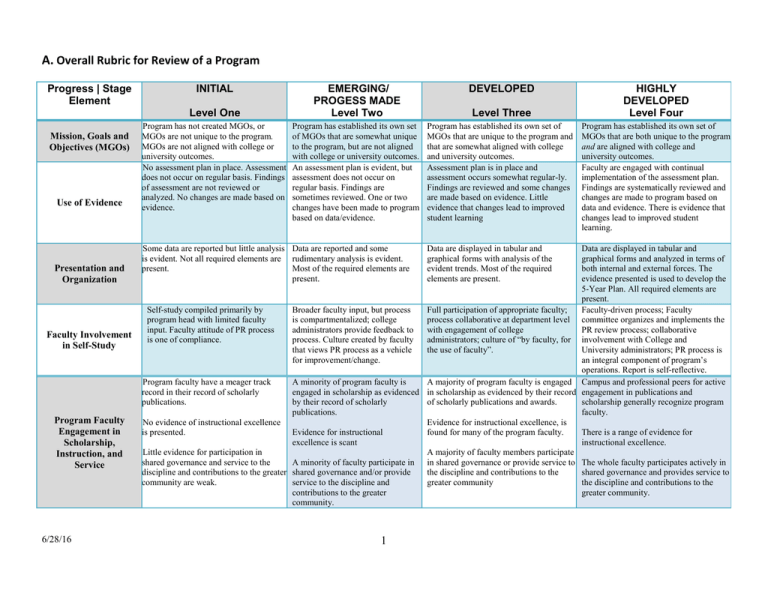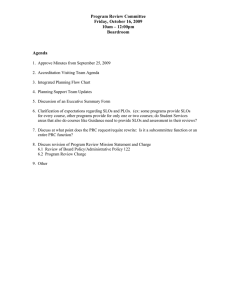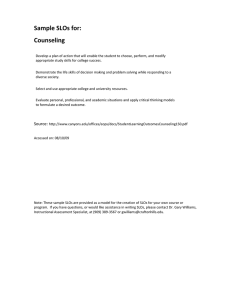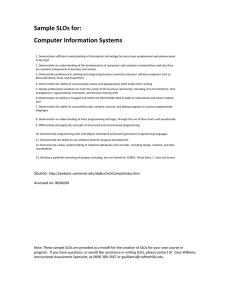Program Review (.doc)
advertisement

A. Overall Rubric for Review of a Program Progress | Stage Element INITIAL Level One EMERGING/ PROGESS MADE Level Two DEVELOPED Program has established its own set of MGOs that are somewhat unique to the program, but are not aligned with college or university outcomes. An assessment plan is evident, but assessment does not occur on regular basis. Findings are sometimes reviewed. One or two changes have been made to program based on data/evidence. Program has established its own set of MGOs that are unique to the program and that are somewhat aligned with college and university outcomes. Assessment plan is in place and assessment occurs somewhat regular-ly. Findings are reviewed and some changes are made based on evidence. Little evidence that changes lead to improved student learning Use of Evidence Program has not created MGOs, or MGOs are not unique to the program. MGOs are not aligned with college or university outcomes. No assessment plan in place. Assessment does not occur on regular basis. Findings of assessment are not reviewed or analyzed. No changes are made based on evidence. Presentation and Organization Some data are reported but little analysis Data are reported and some is evident. Not all required elements are rudimentary analysis is evident. present. Most of the required elements are present. Mission, Goals and Objectives (MGOs) Faculty Involvement in Self-Study Program Faculty Engagement in Scholarship, Instruction, and Service 6/28/16 Level Three Program has established its own set of MGOs that are both unique to the program and are aligned with college and university outcomes. Faculty are engaged with continual implementation of the assessment plan. Findings are systematically reviewed and changes are made to program based on data and evidence. There is evidence that changes lead to improved student learning. Data are displayed in tabular and graphical forms and analyzed in terms of both internal and external forces. The evidence presented is used to develop the 5-Year Plan. All required elements are present. Self-study compiled primarily by Broader faculty input, but process Full participation of appropriate faculty; Faculty-driven process; Faculty program head with limited faculty is compartmentalized; college process collaborative at department level committee organizes and implements the input. Faculty attitude of PR process administrators provide feedback to with engagement of college PR review process; collaborative is one of compliance. process. Culture created by faculty administrators; culture of “by faculty, for involvement with College and that views PR process as a vehicle the use of faculty”. University administrators; PR process is for improvement/change. an integral component of program’s operations. Report is self-reflective. Program faculty have a meager track A minority of program faculty is A majority of program faculty is engaged Campus and professional peers for active record in their record of scholarly engaged in scholarship as evidenced in scholarship as evidenced by their record engagement in publications and publications. by their record of scholarly of scholarly publications and awards. scholarship generally recognize program publications. faculty. No evidence of instructional excellence Evidence for instructional excellence, is is presented. Evidence for instructional found for many of the program faculty. There is a range of evidence for excellence is scant instructional excellence. Little evidence for participation in A majority of faculty members participate shared governance and service to the A minority of faculty participate in in shared governance or provide service to The whole faculty participates actively in discipline and contributions to the greater shared governance and/or provide the discipline and contributions to the shared governance and provides service to community are weak. service to the discipline and greater community the discipline and contributions to the contributions to the greater greater community. community. 1 Data are displayed in tabular and graphical forms with analysis of the evident trends. Most of the required elements are present. HIGHLY DEVELOPED Level Four Faculty distribution across the fields of the discipline is informed by historical assignments without consideration of evolving curricula. Faculty Utilization within a Program Student Engagement and Learning Experiences Curriculum and Instruction Faculty distribution across the fields of the discipline informed by perceived curricular needs, not results of outcomes assessment or a review of peer institutions. Faculty distribution across the fields of the discipline informed by comparison to peer institutions or by results of outcomes assessment. Faculty distribution across the fields of the discipline informed by comparison to peer institutions, disciplinary trends and results of outcomes assessment. Temporary/adjunct faculty teach a large fraction of courses across the curriculum. Temporary/adjunct faculty teach a significant fraction of courses There is little or no evidence for training mostly in the lower division. of graduate teaching associates (if utilized) before they can be the instructor There is little or no evidence for of record. training of graduate teaching associates (if utilized) before they can be the instructor of record. Almost no students are involved in Very few students are involved in high-impact activities (clubs, service high-impact activities (clubs, learning, research w faculty). Program service learning, research w lacks culminating experience that faculty). Program lacks allows integrative learning. culminating experience that allows integrative learning. All upper division/graduate courses are taught by tenured/tenure track faculty or highly qualified temporary/adjunct faculty current in the field. All courses are taught by tenured/tenure track faculty or highly qualified Temporary/adjunct faculty current in the field. Graduate teaching associates (if utilized) are trained before they can be the instructor of record. Graduate teaching associates (if utilized) are trained before they can be the instructor of record. Some program students are actively engaged in high-impact activities (clubs, service learning, internships, research with faculty, learning communities). Program has a culminating experience but it may not allow integrative learning. Large numbers of program students are actively engaged in high-impact activities (service learning, internships, research with faculty, learning communities). Program has a culminating experience that promotes integrative learning. Static, conservative curriculum unreflective of changes in the field. Stand-alone courses are not integrated or reflective of student needs. No capstone/culminating or serving learning courses. Somewhat static curriculum may reflect current practice in the field but is not developmental in design to reflect the needs of students. No capstone/culminating or service learning courses. Curriculum is mostly reflective of current practice in the discipline. Well-planned program incorporates capstone/culminating service courses, although these are not necessarily integrated into the curriculum. See Rubric B See Rubric B See Rubric B Innovative, dynamic curriculum is reflective of current practice in the discipline. Well-planned program design reflects students’ developmental (pedagogical) needs. Intentionally incorporates capstone/culminating events and service learning courses into the curriculum. See Rubric B See Rubric C See Rubric C See Rubric C See Rubric C Assessment of Student Learning Five Year Plan Original created by WASC. Initially adapted by B. Holzman, SFSU, 10/06 *I (Introduced), D (Developed), M (Mastery). Additions/revisions by C. Ney, Cal Poly SLO 2007 Additions, edits by A Hafner and C Haras, PRS, Cal State LA 2009, additional development added by CSUN, Program review Office, Fall 2010. 6/28/16 2 B. Evaluating Program-level Assessment for Program Review Self Study. Progress | Stage Element INITIAL Level One Student Learning Outcomes (SLOs) Curriculum/ Program Mapping Methods/Measures Student learning outcomes vague and not measurable. Courses or experiences listed but there are no links to SLOs. Student learning outcomes are specific, measurability unclear. Courses listed and may be linked to SLOs, but no clear levels of learning defined. Methods/measures listed but are vague and not linked to SLOs. Methods not specified. Methods/measures listed and linked to SLOs. Only indirect measures/methods used (e.g. surveys). Identified faculty committee w/some limited administrative support. Some evidence of data collection. Some use of technology. Findings are explained, but not linked to SLOs or standards. Findings are current, but not accessible online. Some students are aware of findings. Presentation and Publication of Findings Assessment is assigned to a core faculty working group. Uses of technology identified. Lack of administrative support. Very little data collection. Some findings are presented, but are unavailable online or inaccessible/vague/not comprehensive. Students are not aware of findings Use of Findings Findings discussed among faculty but no change made in program. No annual reports. Assessment Infrastructure EMERGING/ PROGESS MADE Level Two Findings regularly discussed by faculty and issues are identified. Annual reports are sometimes seen. DEVELOPED Level Three HIGHLY DEVELOPED Level Four Student learning outcomes specific to program and measurable. Courses are listed and are linked to SLOs. Clear levels of learning are defined for SLOs at all levels (I, D, M)*. Some mapping evident. Program level outcomes map to college and institutional outcomes. Multiple methods and measures used and linked to SLOs. Assessment at only 1 level of learning. Indirect and direct methods used. Faculty committee and program faculty communicate regularly. Admin support evident and evidence seen of regular data collection. Regular use of technology seen. Findings explained and available online, current and accessible and some are linked to SLOs or standards. Some students are aware of findings Student learning outcomes specific to program, detailed, and measurable. Courses listed and linked to SLOs. Levels of learning defined for SLOs at all levels (I, D, M)*. Clearly defined curriculum map with defined levels. Program level outcomes map to college and institutional outcomes. Multiple methods and measures used & linked to outcomes. Assessment performed at all levels (I, D, M)*. Authentic performance-based direct & indirect methods are used. Faculty committee & assessment coordinator communicate with program faculty, connect to college and institutional efforts. Admin support evident. Regular data collection. Sophisticated use of technology evident. Current findings are available online and are linked to SLOs or standards. Graphs are used to displays patterns and trends. Most students are aware of findings. Findings discussed among faculty, issues are identified and changes are made to program (e.g. pedagogy, courses changed or added) Annual reports seen. Findings widely disseminated among faculty. Faculty actively use and promote findings and make changes for program improvement. Annual reports consistently show all elements of assessment- especially “closing the loop”. Original created by WASC. Initially adapted by B. Holzman, SFSU, 10/06 *I (Introduced), D (Developed), M (Mastery). Additions/revisions by C. Ney, Cal Poly SLO 2007 Additions, edits by A Hafner and C Haras, PRS, Cal State LA 2009, additional development added by CSUN, Program review Office, Fall 2010. 6/28/16 3 C. Evaluating Five-year Plans for Program Review Progress | Stage Element INITIAL Level One Internal Recommendations Curricular Changes Student Factors (including SLOs) Resources Action Plan and Timeline Faculty Issues EMERGING/ PROGESS MADE Level Two Level Three HIGHLY DEVELOPED Level Four Plan does not discuss recommendations and concerns identified in the PR self-study. Plan does not address anticipated curricular changes or challenges e.g. emerging developments that may affect program curriculum. Limited discussion of recommendations and concerns identified in the PR self study Recommendations and concerns identified in the PR self-study are partially addressed. Recommendations and concerns identified in the PR self-study are thoroughly addressed. Some attempt is made to address curricular changes or challenges/emerging developments that may affect curriculum. Specific curricular changes are discussed as they are affected by emerging developments using recent supporting data. Specific curricular changes are discussed and are based on historical data/evidence. Trends are identified. No student factors discussed in plan. No documented planning in the areas of curriculum, outreach, scheduling, and student retention. Student factors mentioned but not used to inform planning. Limited planning in the areas of curriculum, outreach, scheduling and student retention is documented. Some student factors based on trends are described. Preliminary planning in the areas of curriculum, outreach, scheduling and student retention are documented. Multiple student factors based on trends are described and used in planning. Specific plans in the areas of curriculum, outreach, scheduling and retention are discussed. Inadequately funded programs also show planning to meet students’ needs. No discussion of resource adequacy. No 5-yr planning for resources. Limited discussion of adequacy of resources; no resource planning for a 5-yr period. Detailed analysis of resource adequacy for the 5yr period. Identify needs based on program priorities using data. No action plan or timeline included. Partial action plan and brief timeline included. No discussion of faculty trends that affect program development; no planning is evident. Limited discussion of faculty trends (program development, recruitment, retention) based on anecdotal evidence. Preliminary analysis of adequacy of resources for 5-yr period. Needs are identified but not based on program priorities or data. Preliminary action plan included. May include revised curriculum, timeline for task, person/committee. Discussion of faculty trends. Preliminary planning for program development as affected by faculty recruitment/retention/needs. Ctd. next page 6/28/16 DEVELOPED 4 Full plan includes: specific actions or changes to be taken (e.g. revision of curriculum, timeline for task, person/committee responsible, and cost). Explicit planning for program development based on faculty recruitment/ retention/needs. Supporting data used in planning. Progress | Stage Element Faculty Utilization within a Program INITIAL Level One EMERGING/ PROGESS MADE Level Two No discussion of faculty trends that affect program development; no planning is evident. Limited discussion of faculty trends (program development, recruitment, retention) based on anecdotal evidence DEVELOPED Level Three HIGHLY DEVELOPED Level Four Discussion of faculty trends. Preliminary Explicit planning for program development based planning for program development as on faculty recruitment/ retention/needs. Supporting affected by faculty data used in planning. recruitment/retention/needs. Faculty distribution across the fields of the Faculty distribution across the Faculty distribution across the Faculty distribution across the fields of discipline informed by comparison to peer fields of the discipline is fields of the discipline informed by the discipline informed by comparison to institutions, disciplinary trends and results of informed by historical perceived curricular needs, not peer institutions or by results of outcomes assessment. assignments without results of outcomes assessment or a outcomes assessment. consideration of evolving review of peer institutions. All courses are taught by tenured/tenure track curricula. All upper division/graduate courses are faculty or highly qualified Temporary/adjunct Temporary/adjunct faculty teach a taught by tenured/tenure track faculty or faculty current in the field. Temporary/adjunct faculty significant fraction of courses highly qualified temporary/adjunct teach a large fraction of courses mostly in the lower division. faculty current in the field. Graduate teaching associates (if utilized) are across the curriculum. trained before they can be the instructor of There is little or no evidence for Graduate teaching associates (if record. There is little or no evidence training of graduate teaching utilized) are trained before they can be for training of graduate teaching associates (if utilized) before they the instructor of record. associates (if utilized) before can be the instructor of record. they can be the instructor of record. Original created by WASC. Initially adapted by B. Holzman, SFSU, 10/06 *I (Introduced), D (Developed), M (Mastery). Additions/revisions by C. Ney, Cal Poly SLO 2007 Additions, edits by A Hafner and C Haras, PRS, Cal State LA 2009, additional development added by CSUN, Program review Office, Fall 2010. 6/28/16 5



